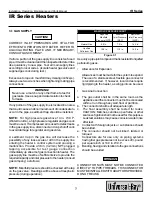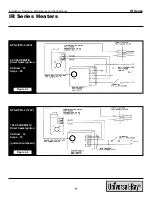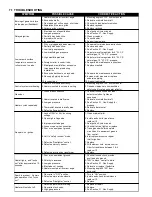
10
IR Series
Installation, Operation, Maintenance and Parts Manual
Detroit Radiant Products Company
5.1 Ventilation
Ventilation of upper levels of the space to be heated
is required to supply combustion air to the heaters in
order to sufficiently dilute the products of combustion.
This also prevents excessive humidity buildup. With
heaters mounted overhead and a properly designed
ventilation system, products of combustion and
excessive drafts will never be present at occupancy
levels.
For proper ventilation, a positive air displacement
of 4.0 CFM per 1000 BTU/H of natural gas
consumed must be provided. If propane is used, a
positive air displacement of 4.5 CFM per 1000
BTU/H of propane gas consumed must be provided.
Many large industrial buildings have sufficient air
movement to satisfy these dilution requirements.
However, in tightly constructed buildings where
insufficient air movement exists, induced air
displacement is required. This air displacement may
be accomplished by either gravity or mechanical
means. Provisions must be made to provide
sufficient fresh air intake area and exhaust air outlet
area. This is essential to provide a balanced system
to avoid negative building pressure which cause
excessive infiltration and unfavorable drafts thereby
affecting efficient combustion of infrared heaters.
Mechanical exhausters are preferred and typically
mounted at high points of the building on areas of
the roof where stagnant air can accumulate under
the deck. For a flat roof, considerations of prevailing
winds, high and low pressure areas, and distribution
of air movement must be taken into consideration
when locating exhausters.
Best air distribution is accomplished by using a
number of small exhausters versus one large
exhauster. Approximately one square inch of net
free inlet area per 1000 BTU/H is adequate for
combustion air supply. Inlet opening in the building
should be well distributed high in the sidewalls and
should direct incoming air upward to dilute products
of combustion while preventing drafts at lower levels.
Inlets are typically 1 to 3 sq. ft.
Local codes may require that mechanical exhaust
systems be interlocked with heaters to enable both
to function simultaneously (Figure 4.1 on pg.8). Other
codes may allow control of exhausters with a ceiling
mounted humidistat. Exhausters then operate when
relative humidity rises above humidistat setting.
Since the products of combustion increase the
relative humidity level of the space, this is a feasible
method of controlling exhausters. Selection of a
humidistat setting will vary with different conditions
and areas of the country.






























